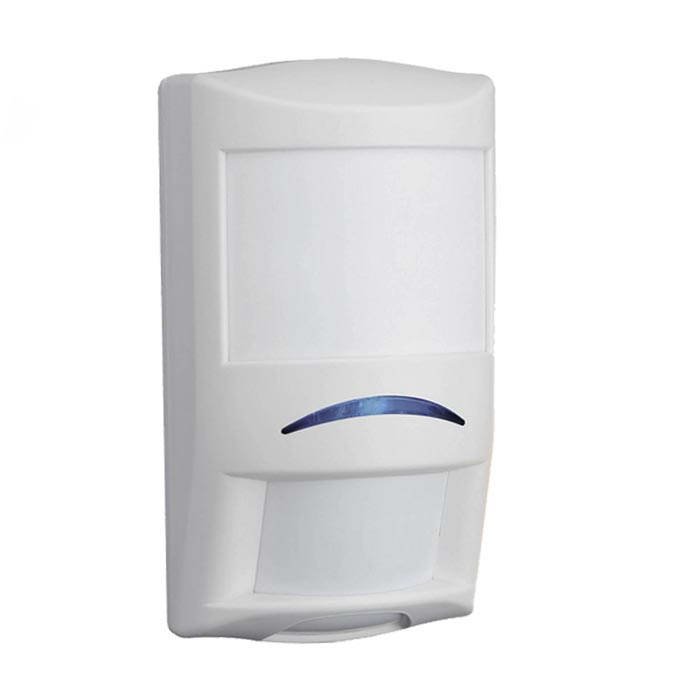Bosch ISC-PDL1-WA18G Professional Series TriTech+ Motion Detectors with Anti‑mask
- 18 m x 25 m (60 ft x 80 ft) standard coverage, 8 m x 10 m (25 ft x 33 ft) selectable short range coverage
- EN50131-2-4 Grade 3 compliant
- Sensor data fusion technology
- Tri-focus optics technology
- Range adaptive radar
- MANTIS anti-mask
- Active white light suppression
- Dynamic temperature compensation
- Remote walk test
- Alarm memory
- Draft and insect immunity
- 2 m to 3 m (7 ft to 10 ft) mounting height, no adjustments required
This device is exceptionally suited for commercial indoor applications. MANTIS anti-mask technology makes obscuring the detector view nearly impossible for intruders. Sensor data fusion technology ensures that the detector sends alarm conditions based on precise information. Tri‑focus optics eliminate coverage gaps and respond efficiently to intruders. The powerful combination of unique features in the Professional Series delivers superior catch performance and virtually eliminates false alarms.
The self-locking two-piece enclosure, built-in bubble level, flexible mounting height, and three optional mounting brackets simplify installation and reduce service time.
Sensor Data Fusion Technology
Sensor data fusion technology is a unique feature that uses a sophisticated software algorithm to gather signals from five sensors: two pyroelectric sensors, a range adaptive radar sensor, a room temperature sensor, and a white light level sensor. The microcontroller analyzes and compares the sensor data to make the most intelligent alarm decisions in the security industry.
Tri-focus Optics Technology
Tri-focus optics technology uses optics with three specific focal lengths: long-range coverage, middle- range coverage, and short-range coverage. The detector applies the three focal lengths to 86 detection zones, which combine to make 11 solid curtains of detection. Tri-focus optics technology also includes two pyroelectric sensors, which deliver twice the standard optical gain. The sensors process multiple signals to deliver precise performance virtually free of false alarms.
Range Adaptive Radar
The microwave transceiver automatically adjusts its detection thresholds based on input from the PIR sensors. Integrating the target distance information from the PIR significantly reduces false alarms from the microwave Doppler radar.
MANTIS Anti-mask Technology
MANTIS (Multi-point Anti-mask with Integrated Spray
detection) uses patented prism lenses and active infrared detection to provide industry-leading protection against all known forms of attack. MANTIS complies with the latest worldwide regulatory standards for detecting objects covering or placed in front of the detector. MANTIS is sensitive to materials regardless of texture or color, including fabric, paper, metal, plastic, tape, and spray. When MANTIS identifies a masking material, the detector sends a supervision anti-mask signal to the control panel.
Active White Light Suppression
An internal light sensor measures the level of light intensity directed at the face of the detector. Sensor data fusion technology uses this information to eliminate false alarms from bright light sources.
Available Coverage
The standard coverage is 18 m x 25 m (60 ft x 80 ft). Installers can set a DIP switch at the detector to select short range coverage of 8 m x 10 m (25 ft x 33 ft).
Dynamic Temperature Compensation
The detector automatically adjusts PIR sensitivity to identify human intruders at critical temperatures.
Dynamic temperature compensation detects human body heat accurately, avoids false alarms, and delivers consistent catch performance at all operating temperatures.
Cover and Wall Tamper Switch
When an intruder removes the cover or attempts to separate the detector from the wall, a normally-closed contact opens to alert the control panel.
Draft, Insect, and Small Animal Immunity
The sealed optic chamber provides immunity to drafts and insects, reducing false alarms. Small animal immunity reduces false alarms caused by animals less than 4.5 kg (10 lb), such as rodents.
Remote Self Test
A remote self-test initiates when the walk test input switches to its true state. The alarm relay and alarm LED activate for four seconds following a successful test. The trouble relay activates, and the alarm LED flashes following a failed test.
Input Power Supervision
When the power is lower than 8 V, a low input power trouble condition activates the trouble relay and causes the LED to flash. The trouble condition clears automatically when power reaches or exceeds 8 V.
Trouble Memory
When the walk test input switches to its true state for less than two seconds, the LED flashes to indicate the most recent trouble condition. If there is no trouble in memory, the LED does not flash. After twelve hours, or after the detector receives a second walk test pulse for two seconds or less, the LED stops flashing and the trouble memory clears.
Cloak and Camouflage Detection Technology Cloak and Camouflage Detection Technology (C2DT) maximizes catch performance against intruders
attempting to cover their infrared signal.
DIP Switch Programming
The following functions are all programmed using DIP switch settings:
- Local Walk Test LED
- Remote Walk Test Input Polarity
- Alarm Memory Polarity
- Long and Short Range Select
- MANTIS Anti-mask On and Off
Self-adjusting LEDs
The LED brightness adjusts automatically to the surrounding light level. A blue light-emitting diode (LED) indicates TriTech+ alarms and activates during a walk test. A yellow LED indicates microwave detection, and a red LED indicates PIR detection.
Remote Walk Test LED
Users can enter a command through a keypad, a control center, or programming software to remotely enable or disable the walk test LED.
Alarm Memory
Alarm memory flashes the alarm LED to indicate stored alarms for use in multiple unit applications. A switched voltage from the control panel controls the alarm memory.
Solid State Relays
Solid state relays send silent alarm output signals to provide a higher level of security and reliability. An external magnet does not activate the relay. The solid state relay uses less current than a mechanical relay, providing longer standby capacity during a power loss.

